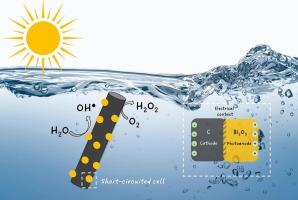一种Bi2O3/碳复合材料作为水净化的短路电池
IF 6.7
2区 工程技术
Q1 ENGINEERING, CHEMICAL
引用次数: 0
摘要
碳/铋氧化物C/Bi2O3复合结构被证明可以作为废水处理的短路电池。采用医生刀、滴涂和物理气相沉积(PVD)三种沉积技术在碳毡(CF)表面沉积氧化铋纳米颗粒。获得了复合材料的结构、微观结构和光学性能,以评价Bi2O3与碳毡之间的电接触。采用循环伏安法(CV)分别评价了Bi2O3和碳的光阳极和阴极性质。虽然发现C/Bi2O3排列以及单独的复合材料能够产生活性氧(ROS),但与单独材料相比,C/Bi2O3光电流密度j要高得多。研究了短路电池(C/Bi2O3)在暗光、可见光、缺氧和含氧饱和环境下对模型有机污染物的降解效率。值得注意的是,短路的C/Bi2O3系统在前10分钟内实现了70 - 90%的污染物降解。•OH自由基和H2O2演化的定量分析表明,在光辅助C/Bi2O3细胞中,阴极和阳极反应都有助于ROS的生成。值得注意的是,污染物的降解不仅发生在无光条件下,而且发生在缺氧和氧饱和条件下。基于Mott-Schottky分析测量的Bi2O3和碳的带边电位(ECB和EVB),提出了电子转移和反应机制。这种电偶联的C/Bi2O3复合材料代表了一种创新策略,具有重大的技术潜力,可用于太阳能光激活的废水处理高级氧化工艺。本文章由计算机程序翻译,如有差异,请以英文原文为准。

A Bi2O3/carbon composite as a short-circuited cell for water purification
A carbon/bismuth oxide C/Bi2O3 composite arrangement is demonstrated to function as a short-circuited cell for wastewater treatment. Bismuth oxide nanoparticles were deposited on carbon felt (CF) surfaces using three deposition techniques: doctor blade, drop coating and physical vapor deposition (PVD). The structural, microstructural and optical properties of the resulting composites were obtained to evaluate the electrical contact between Bi2O3 and carbon felt. Cyclic voltammetry (CV) was employed to assess the photoanodic and cathodic nature of Bi2O3 and carbon, respectively. Although the C/Bi2O3 arrangement as well as the separate composite materials were found to be capable of producing reactive oxygen species (ROS), the C/Bi2O3 photocurrent density j was substantially higher when compared to that of the separate materials. The efficiency of the short-circuited cell (C/Bi2O3) was evaluated for the degradation of a model organic pollutant under dark and visible light and under anoxic and oxygen-saturated atmospheres. Remarkably, the short-circuited C/Bi2O3 system achieved 70–90 % pollutant degradation within the first 10 min. Quantification of •OH radicals and H2O2 evolution indicated that both cathodic and anodic reactions contribute to ROS generation in the photo-assisted C/Bi2O3 cell. Notably, pollutant degradation occurred not only in the absence of light, but also under both anoxic and oxygen saturated conditions. The proposed electron transfer and reaction mechanisms are based on the measured band edge potentials (ECB and EVB) of Bi2O3 and carbon from Mott-Schottky analysis. This electrically coupled C/Bi2O3 composite represents an innovative strategy with significant technological potential for solar-light-activated advanced oxidation processes for wastewater treatment applications.
求助全文
通过发布文献求助,成功后即可免费获取论文全文。
去求助
来源期刊

Journal of water process engineering
Biochemistry, Genetics and Molecular Biology-Biotechnology
CiteScore
10.70
自引率
8.60%
发文量
846
审稿时长
24 days
期刊介绍:
The Journal of Water Process Engineering aims to publish refereed, high-quality research papers with significant novelty and impact in all areas of the engineering of water and wastewater processing . Papers on advanced and novel treatment processes and technologies are particularly welcome. The Journal considers papers in areas such as nanotechnology and biotechnology applications in water, novel oxidation and separation processes, membrane processes (except those for desalination) , catalytic processes for the removal of water contaminants, sustainable processes, water reuse and recycling, water use and wastewater minimization, integrated/hybrid technology, process modeling of water treatment and novel treatment processes. Submissions on the subject of adsorbents, including standard measurements of adsorption kinetics and equilibrium will only be considered if there is a genuine case for novelty and contribution, for example highly novel, sustainable adsorbents and their use: papers on activated carbon-type materials derived from natural matter, or surfactant-modified clays and related minerals, would not fulfil this criterion. The Journal particularly welcomes contributions involving environmentally, economically and socially sustainable technology for water treatment, including those which are energy-efficient, with minimal or no chemical consumption, and capable of water recycling and reuse that minimizes the direct disposal of wastewater to the aquatic environment. Papers that describe novel ideas for solving issues related to water quality and availability are also welcome, as are those that show the transfer of techniques from other disciplines. The Journal will consider papers dealing with processes for various water matrices including drinking water (except desalination), domestic, urban and industrial wastewaters, in addition to their residues. It is expected that the journal will be of particular relevance to chemical and process engineers working in the field. The Journal welcomes Full Text papers, Short Communications, State-of-the-Art Reviews and Letters to Editors and Case Studies
 求助内容:
求助内容: 应助结果提醒方式:
应助结果提醒方式:


